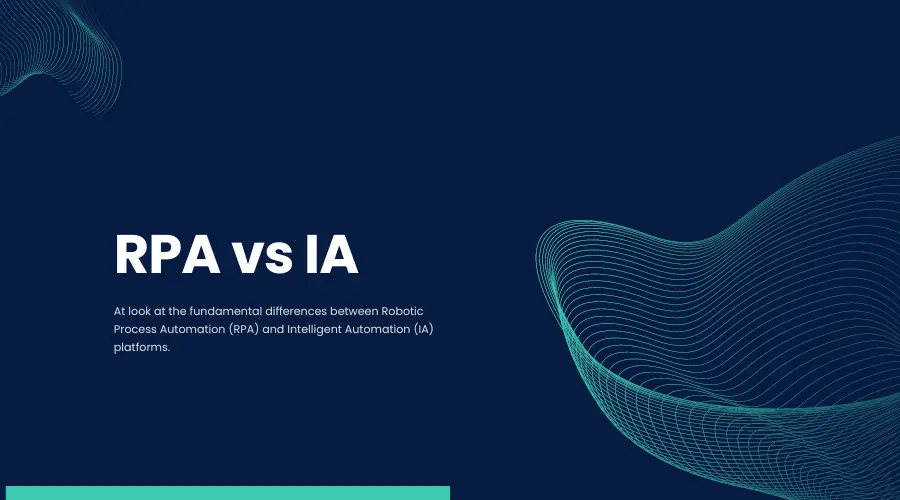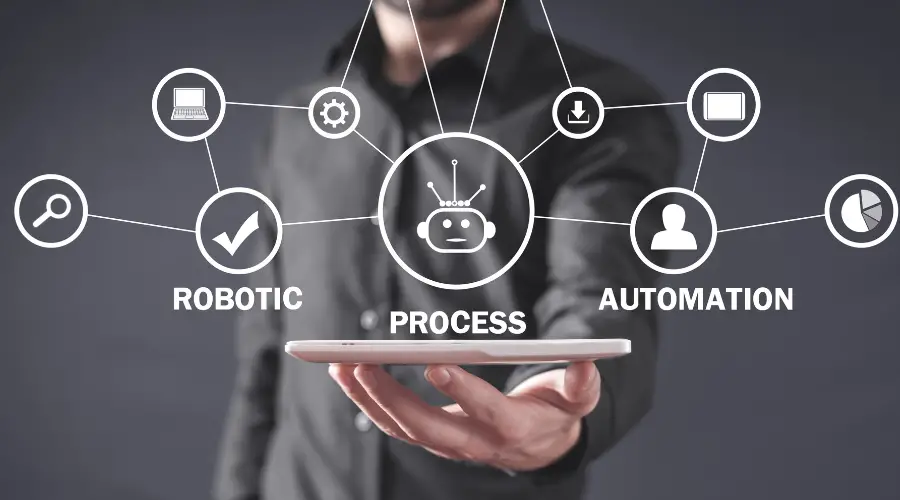In the realm of automation, businesses are exploring the benefits of RPA vs IA. RPA streamlines repetitive tasks, while IA leverages AI for adaptive decision-making.
Understanding the distinctions between these two approaches is vital for informed automation decisions that optimize processes and empower teams.
RPA vs IA: Key Differences
Definition and Purpose
RPA (Robotic Process Automation) is a technology that automates repetitive, rule-based tasks by mimicking human actions. It’s perfect for relieving you from monotonous, time-consuming, and non-value-added work.
IA (Intelligent Automation), on the other hand, refers to the combination of RPA and artificial intelligence (AI) technologies. Tools like the intelligent automation platform from Kofax go beyond simple automation, enabling software robots to understand, learn, and make decisions.
Technologies Involved
RPA mainly involves software robots, which interact with digital systems to perform tasks without requiring human intervention. This helps you save time and achieve operational accuracy.
Intelligent Automation consists of a wide range of AI technologies, including:
- Machine Learning: Allows your software robots to learn and improve from experience without explicit programming.
- Natural Language Processing: Enhances understanding and generation of human language, making your automation processes more human-like.
- Structured Data Interaction: Helps robots to better understand and interact with structured data feeds, increasing the scope of automation capabilities.
- Intelligent Document Processing: Empowers robots with the ability to read and interpret documents like an employee, speeding up processes involving documentation.
Scope of Automation
RPA is well-suited for automating tasks that involve structured data and have clear, predefined rules. Examples include data entry, data validation, and invoice processing. By automating such tasks, you can reduce errors and increase productivity.
Intelligent Automation goes a step further, automating tasks that require contextual understanding and decision-making. This includes sentiment analysis, customer support automation, and inventory control.
By leveraging AI capabilities, you can automate more complex and varied tasks, boosting efficiency across your organization.
Benefits and Challenges of RPA
Cost Reduction and Efficiency
By implementing RPA, you can reduce your operational costs and increase efficiency. RPA automates repetitive tasks, freeing up your employees to focus on higher-value activities. This can lead to faster processing times and fewer errors, as RPA robots can work 24/7 without the need for breaks or time off. In turn, your organization becomes more productive and cost-effective.
Scalability and Flexibility
Your RPA implementation has the potential to be easily scaled and adapted to changing business needs. As your organization grows or experiences fluctuations in workload, you can add or remove RPA bots accordingly.
It’s a flexible solution that allows you to quickly respond to market demands and minimize potential downtime.
Implementation Challenges
However, RPA does come with its challenges. First and foremost, it requires a clear understanding of your business processes and the tasks suitable for automation. Failure to properly analyze and map processes can cause automation projects to underperform or even fail.
Additionally, your IT infrastructure must be updated and compatible with RPA tools, which could mean additional costs and potential complexities.
Lastly, you need to consider the impact of RPA on your workforce and develop strategies for effective change management during implementation.
Benefits and Challenges of IA
Cognitive Abilities
Intelligent Automation (IA) employs artificial intelligence (AI) technologies, such as machine learning, natural language processing, and intelligent document processing, to automate complex tasks.
This means that IA-driven systems can understand vast amounts of data, perform sophisticated analysis, and even make recommendations based on that analysis.
For you, this means IA can handle tasks beyond simple rule-based activities and empower your organization with more advanced automation capabilities.
Adaptability and Learning
Another key benefit of IA is its adaptability and learning capabilities. As IA taps into machine learning algorithms, it can learn from previous experiences, adjust its operations accordingly, and take on new challenges as they arise. This translates into better decision-making abilities, increasing efficiency, and adapting to the ever-changing business environment.
For you, it means that your organization will have a system that can grow and evolve alongside your business needs.
Integration Complexities
However, there are some challenges to implementing IA, and one notable hurdle lies in the integration complexities.
Compared to traditional RPA, IA often requires a more complex setup to reach its full potential. The task of integrating IA into existing systems and processes can be time-consuming and costly. Additionally, there might be difficulties in retraining or recruiting skilled employees to harness the power of IA. As you consider IA for your organization, you should weigh these challenges alongside the potential benefits it offers.
Industries and Use Cases
Financial Services and Banking
In Financial Services and Banking, Robotic Process Automation (RPA) is widely used for tasks such as data entry, reconciliation, and fraud detection. With high-volume and tedious work, RPA enhances efficiency and reduces the risk of human errors.
Intelligent Automation (IA) goes a step further by incorporating artificial intelligence (AI) technologies. You can benefit from IA in areas like:
- Credit decision making: IA uses machine learning to analyze data and predict credit risks.
- Customer service: Chatbots with natural language processing (NLP) capabilities provide personalized support to clients.
Healthcare
For the Healthcare industry, RPA plays a crucial role in automating tasks like patient onboarding, appointment scheduling, and billing. This streamlines processes and allows healthcare providers to focus on core patient care activities.
IA can further improve the Healthcare sector with:
- Diagnostics: AI-powered image recognition tools can assist in detecting diseases early on.
- Personalized treatment plans: Machine learning algorithms can analyze patient data and suggest tailored treatments.
Retail and E-commerce
In Retail and E-commerce, RPA is commonly applied to automate inventory management, order processing, and pricing adjustments. This ensures smooth operations and rapid responses to customer needs.
Intelligent Automation brings additional value to Retail and E-commerce through:
- Product recommendations: AI algorithms can analyze customer preferences and suggest relevant products.
- Customer sentiment analysis: NLP can process customer reviews and feedback, helping you make informed business decisions.
Future of RPA and IA
Technological Advancements
In the future, you’ll notice that RPA and IA technologies will continue to evolve. RPA will still be focused on automating repetitive, rule-based tasks, while IA will incorporate even more advanced AI technologies like machine learning and natural language processing. This will help you automate even more complex processes, such as:
- Better decision-making with improved data analysis
- Advanced interaction with unstructured data and documents
- Enhanced customer service through natural language understanding
Impact on Jobs
As RPA and IA become more widespread in organizations, you may see a shift in job responsibilities and even the creation of new roles. While there’s a potential for job displacement in areas with repetitive tasks, the integration of automation technology also presents opportunities for upskilling and transitioning to new roles. For example:
- Employees currently managing repetitive tasks could oversee the operation and management of automation tools
- Professionals may find new opportunities in training and quality assurance roles, ensuring that AI systems are performing optimally
- Companies might invest in reskilling and training programs, enabling employees to work alongside and enhance these technologies
Impact on the Economy
The increased adoption of RPA and IA technologies could have significant implications on the economy, particularly as efficiency and productivity improvements are realized:
- Companies can optimize their processes, reduce costs, and increase profit margins, leading to potential growth and competitiveness
- Sectors that are heavily reliant on manual and repetitive tasks could see a boost in productivity with the adoption of automation technology
- As new roles and markets are created around RPA and IA, there may be increasing demand for skilled professionals in these fields, in turn fostering new educational and career opportunities.
Looking to the future, RPA and IA technologies will continue to evolve, with advancements in AI technologies leading to even more advanced automation capabilities.
While there may be job displacement in areas with repetitive tasks, the integration of automation technology also presents opportunities for upskilling and transitioning to new roles.
The increased adoption of RPA and IA technologies could also have significant implications on the economy, fostering new educational and career opportunities in these fields.



